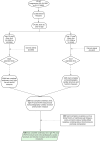Associations of accelerometer-based sedentary time, light physical activity and moderate-to-vigorous physical activity with resting cardiac structure and function in adolescents according to sex, fat mass, lean mass, BMI, and hypertensive status
- PMID: 37035905
- PMCID: PMC10946782
- DOI: 10.1111/sms.14365
Associations of accelerometer-based sedentary time, light physical activity and moderate-to-vigorous physical activity with resting cardiac structure and function in adolescents according to sex, fat mass, lean mass, BMI, and hypertensive status
Abstract
Background: This study examined the independent relationships of device-based measured sedentary time (ST) and physical activity (PA) in relation to cardiac structural and functional geometry among adolescents.
Methods: From the Avon Longitudinal Study of Parents and Children, UK birth cohort, 530 (50% female) adolescents aged 17 years had complete ST, PA, cardiac, and covariate measures. Echocardiography cardiac measures were left ventricular mass indexed for height2.7 (LVMI2.7 ), relative wall thickness, LV diastolic function (LVDF), and LV filling pressure (LVFP). Overweight/obesity and elevated systolic/BP hypertension were categorized as body mass index >24.99 kg/m2 and ≥130 mmHg, respectively. Data were analyzed with linear regression models adjusting for cardiometabolic factors and lifestyle factors.
Results: The prevalence of overweight/obesity in males and females was 17.9% and 24.5%, respectively. The prevalence of elevated systolic BP/hypertension was 11.6% in males and 1.1% among females. The average ST was 484 ± 78 min/day, light PA was 274 ± 62 min/day, and moderate-to-vigorous PA (MVPA) was 41 ± 24 min/day, among females. Average ST, LPA, and MVPA were 468 ± 87 min/day, 293 ± 70 min/day, and 56 ± 30 min/day, respectively, among males. Higher ST was associated with higher LVMI2.7 (standardized β = 0.16; p = 0.01) among females, but higher ST was associated with lower LVDF in males (β = -0.14; p = 0.04). Higher ST and MVPA were associated with higher LVMI2.7 in the total cohort, normal weight, and overweight/obese adolescents. Light PA was associated with higher LVDF in the total cohort and normotensives and lower LVFP among adolescents with high lean mass.
Conclusions: Higher ST and MVPA were associated with higher LVMI; however, ST-associated LVMI increase was threefold higher than MVPA-associated LVMI increase. Higher LPA was associated with better cardiac function. Reducing ST and increasing LPA may attenuate the risk of altered cardiac structure and function in adolescents.
Keywords: cardiac remodeling; exercise; left ventricular hypertrophy; lifestyle factors; movement behavior; pediatrics.
© 2023 The Author. Scandinavian Journal of Medicine & Science In Sports published by John Wiley & Sons Ltd.
Conflict of interest statement
None.
Figures
Similar articles
-
Accelerometer-based sedentary time and physical activity from childhood through young adulthood with progressive cardiac changes: a 13-year longitudinal study.Eur J Prev Cardiol. 2024 Sep 6;31(12):1480-1492. doi: 10.1093/eurjpc/zwae129. Eur J Prev Cardiol. 2024. PMID: 38711312 Free PMC article.
-
Arterial stiffness but not carotid intima-media thickness progression precedes premature structural and functional cardiac damage in youth: A 7-year temporal and mediation longitudinal study.Atherosclerosis. 2023 Sep;380:117197. doi: 10.1016/j.atherosclerosis.2023.117197. Epub 2023 Aug 4. Atherosclerosis. 2023. PMID: 37582328
-
Associations of accelerometer measured school- and non-school based physical activity and sedentary time with body mass index: IPEN Adolescent study.Int J Behav Nutr Phys Act. 2022 Jul 14;19(1):85. doi: 10.1186/s12966-022-01324-x. Int J Behav Nutr Phys Act. 2022. PMID: 35836235 Free PMC article.
-
Associations between physical activity, sedentary behaviour and left ventricular structure and function from the Echocardiographic Study of Latinos (ECHO-SOL).Open Heart. 2021 Jul;8(2):e001647. doi: 10.1136/openhrt-2021-001647. Open Heart. 2021. PMID: 34261776 Free PMC article.
-
Comparison of accelerometer measured levels of physical activity and sedentary time between obese and non-obese children and adolescents: a systematic review.BMC Pediatr. 2018 Mar 9;18(1):106. doi: 10.1186/s12887-018-1031-0. BMC Pediatr. 2018. PMID: 29523101 Free PMC article. Review.
Cited by
-
Mediating effect of fat mass, lean mass, blood pressure and insulin resistance on the associations of accelerometer-based sedentary time and physical activity with arterial stiffness, carotid IMT and carotid elasticity in 1574 adolescents.J Hum Hypertens. 2024 May;38(5):393-403. doi: 10.1038/s41371-024-00905-6. Epub 2024 Feb 26. J Hum Hypertens. 2024. PMID: 38409590 Free PMC article.
-
Effects of accelerometer-based sedentary time and physical activity on DEXA-measured fat mass in 6059 children.Nat Commun. 2023 Dec 12;14(1):8232. doi: 10.1038/s41467-023-43316-w. Nat Commun. 2023. PMID: 38086810 Free PMC article.
-
Longitudinal Mediating Effect of Fat Mass and Lipids on Sedentary Time, Light PA, and MVPA with Inflammation in Youth.J Clin Endocrinol Metab. 2023 Nov 17;108(12):3250-3259. doi: 10.1210/clinem/dgad354. J Clin Endocrinol Metab. 2023. PMID: 37310686 Free PMC article.
-
Associations of Sedentary Time and Physical Activity From Childhood With Lipids: A 13-Year Mediation and Temporal Study.J Clin Endocrinol Metab. 2024 Jun 17;109(7):e1494-e1505. doi: 10.1210/clinem/dgad688. J Clin Endocrinol Metab. 2024. PMID: 38097375 Free PMC article.
-
DXA-based Fat Mass With Risk of Worsening Insulin Resistance in Adolescents: A 9-Year Temporal and Mediation Study.J Clin Endocrinol Metab. 2024 Aug 13;109(9):e1708-e1719. doi: 10.1210/clinem/dgae004. J Clin Endocrinol Metab. 2024. PMID: 38173399 Free PMC article.
References
-
- Agbaje AO, Zachariah JP, Tuomainen TP. Arterial stiffness and carotid intima‐media thickness progression preceding worsening left ventricular hypertrophy and diastolic dysfunction in youth: a temporal causal longitudinal study. Circulation. 2022;146(Suppl 1):A13679. doi:10.1161/circ.146.suppl_1.13679 - DOI
MeSH terms
Grants and funding
LinkOut - more resources
Full Text Sources
Medical
Miscellaneous


